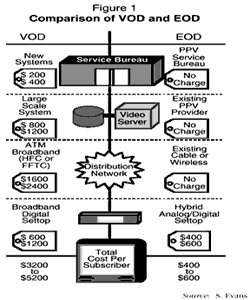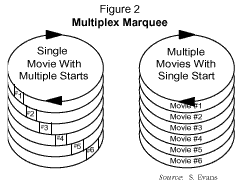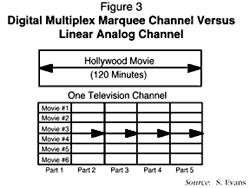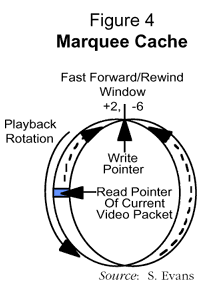
Both VOD and EOD are based upon delivering compressed digital video to the home. To make this happen, four layers of technology have to be put into place and integrated to work together. Each of the layers represents a monumental shift from the current environment. Compounding the problem is the absence of standards-based products, because agreement on the various standards required to build compatible products has -- as usual -- been agonizingly slow in coming. Ergo, the lab experiments for VOD, none of which represent a commitment for wide-scale deployment. These trials and the related technology have received extensive coverage, so we will just do a quick review for the purpose of contrasting VOD and EOD approaches (see Figure 1).

The first layer that has to be in place for VOD is a broadband distribution network capable of delivering hundreds (or thousands) of digital channels simultaneously to the home. Several architectures exist, including Fiber To The Curb (FTTC), Hybrid Fiber/Coax (HFC), and Asymmetrical Digital Subscriber Line (ADSL). All require a switching component, with the Asynchronous Transfer Mode (ATM) fast packet format gaining the consensus as the long-term winner. Another alternative is similar to cellular telephony, where channels are assigned dynamically to subscribers. These approaches require a tremendous investment in proprietary solutions which may (or may not) become "de facto" standards if they reach a high enough level of deployment. Where VOD and EOD diverge is that EOD is intended to be an overlay to existing infrastructures, allowing them to migrate to broadband rather than deploying parallel networks. Further, EOD utilizes a broadcast scheme as opposed to creating a virtual channel to the subscriber's home.
The second layer is the digital set-top box required in the subscriber's home to receive and decode the digital signals. A number of companies are designing digital set-top boxes, most of which have a common baseline in their design -- specifically, the use of MPEG as the digital video format. The fully digital broadband box required for VOD is both more expensive and complex than the hybrid analog/digital box used for EOD. The functionality is essentially the same, as are the picture and audio quality.
The third layer is the video server, which reads prerecorded digitized compressed video information off of some storage media (usually optical disc) and feeds it to the subscriber's home for the digital set-top box to decode and display on the television screen. This server for VOD must be able to handle many high-speed channels simultaneously. The VOD server and the set-top box must use the same control signals, and the broadband network must be able to pass those signals end-to-end for VCR-like functions (pause/stop, fast forward, rewind) to work. The EOD approach uses a smaller server that only sends out a limited number of video streams, constantly broadcasting the same information in a repetitive pattern known as a Marquee.
The fourth layer is the service bureau which takes the order from the subscriber, creates the billing stream, and authorizes the delivery of the video signal. Whether you call it a back office system or look at it like a service bureau, it still has to exist before the service can be deployed. The VOD version of the service bureau is still being defined, while EOD makes use of the existing pay-per-view (PPV) bureaus.
This creates a serious problem, as reflected in the RBOC Video Dialtone filings with the FCC Carrier Bureau, which showed the payback stretching out between eight and 12 years -- well beyond the seven-year depreciation schedule under which the investment would be made. To paraphrase the head of a computer company who had initially placed great importance on the VOD server market, "every subscriber would have to sit home and watch movies 24-hours-a-day for 10 years in order for this to pay off!"
With EOD, all of the various products that can be time shifted will contribute revenue. Sports, soap operas, your favorite sitcom, distance learning -- they all add up in the revenue column. Trials by Your Choice TV show that viewers are willing to pay $1 for a TV show they missed and up to $2.99 for miniseries and specials. So EOD, with its broader range of choices and lower cost for deployment, gives the service provider a fighting chance at showing a profit in a timeframe that can be financed.
What's needed is a way to deliver a digital video signal to the subscriber willing to pay an additional $10 to $20 per month for programs (including movies) in digital format. The monthly subscription fee pays for the EOD hybrid analog/digital set-top box that receives both analog and digital information and decodes the signals. An internal modem that plugs into the subscriber's telephone jack provides telephone access to order movies, TV shows, or any other type of programming made available on a "pay-per-play" basis. The same service bureaus that take the orders for PPV movies and events take the subscriber's EOD order and send a message to the broadcast point (MMDS or cable headend) to relay the enabling code to the subscriber's set-top box, and tell it to decode a specific digital channel so the program can be viewed. This effectively eliminates the need for a broadband delivery system while leveraging the existing PPV program provider and/or service bureau capabilities to solve the back office and billing problems. For the service provider, the existing PPV providers are more than willing to provide a digital encoded signal along with the traditional analog signal.
But increasing the start times impacts carriage. Carriage means providing a channel to carry the signal on. A combination of regulatory hassles and aging cable plants have caused most cable systems to run out of channel capacity. Bad news for PPV providers, which currently have between two and four channels available to them on a cable system. Especially since the second factor in increasing the buy rate is to offer more movies, as long as they're in the "top 10" at the local video stores. Double the number of movies available, and you double the buy rates. So a "push-pull" dynamic exists here, where more movies and more start times both drive the buy rates up. Yes, doubling the number of movies and the number of start times effectively quadruples the buy rates. But carriage restrictions constrict the opportunity, forcing an upgrade or rebuild of the system to provide more carriage, which increases the mortgage, which reduces the profits because of the spiraling costs. How can this problem be solved?
In a way, you probably already know what to do. Drive by your local Cineplex, and the answer is staring you in the face. Offer a choice of movies in one place, showing simultaneously. Oddly enough, the digital video equivalent of Cineplex is Multiplex. No, we're not mixing metaphors. It has to do with digital compression for video. The MPEG format allows for between six and 10 video streams to be multiplexed into one television channel frequency. In the cable world, this is known as channel replacement, i.e., replace one analog TV channel with up to 10 digital ones. This is the source of John Malone's famous "500 channels." Most cable systems have 50 usable channels, and if you replaced all of the analog channels with digital ones, the result would be 500 digital channels. This is not practical, since every subscriber would need a shiny new digital set-top box -- but at least the math works.
Let's use the MPEG compressed digital video format to multiplex video streams and make them function as if they really were "on demand." We need a video server, but only a small one that plays the same movies over and over and over again, with one multiplexed stream feeding into an analog television channel. In this scenario, the movie is sent out in a repetitive stream, creating the Marquee mentioned earlier, with the whole movie being broadcast in chunks that are multiplexed together in the digital video stream (see Figure 2). Chop the movie into pieces, and it reduces the playing time to broadcast the whole movie. Broadcast only one movie per channel and you can have 10 starts in the same time allotment, typically 120-minute intervals. Another option is to broadcast multiple movies on one channel with only one start time, which is the Cineplex model.

The Marquee contains the compressed video information, surrounding it with a frame pattern that identifies what information is present and the relative location in the overall sequence. Embedded in the frame pattern is a control channel providing the information necessary to capture and reconstruct the video stream so it can be decoded by the EOD set-top. The control channel is reserved for information required to distribute and manage the multiplex streams to minimize overhead.
Depending on the multiplex scheme used, the balance between the number of movies and start times can be adjusted to optimize the buy rates. Broadcast two movies per channel, and you can have five starts in the same time. Five movies can have two starts per hour. Send the signal out in a more complex interleave pattern, and you can have enough movies and start times so that the quadruple effect kicks in. Again, this has been proven by the Cineplex model, which allocates more screens to those movies that can fill the seats. The net result is to replace the traditional analog signal showing the movie in linear mode with a digital signal that allocates the bandwidth as time slots so traditional multiplexing schemes can be applied (see Figure 3).

This brings the cost per subscriber into the realm of reality, somewhere between $400 and $600 per box if the only application to be supported is EOD. The cost may vary slightly, depending on whether the service is provided over cable, MMDS, or satellite (including DBS), but the basic platform remains the same. A plug-in module known as a Network Interface Module (NIM) is used to adapt the box to a specific medium or delivery system format. The balance of the circuitry included is common for what is known as a "hybrid" set-top box capable of receiving both analog and digital signals and displaying them on a television screen. Information delivered with the video stream identifies which movies and programs are available, along with the price for viewing. A button on the special remote control provided with the box activates an on-screen menu which displays the list of movies available, the start times, and the price. The subscriber selects a movie by scrolling through the list and pressing the "Order" button. The box uses an internal modem to dial the service bureau, which, in turn, issues the enabling command to the box, either via the modem connection or over the same channel carrying the digital signal.
The result is an inclusive business model, with both the service provider and their subscribers benefiting from the competition. The EOD model can be used to deliver programs from one or more sources to the subscriber's home, with channels allocated to each programming provider for their multiplex signals. The traditional PPV providers can continue to do business by offering an enhanced service with more movies and more start times, and the service provider can take advantage of multiple program sources, including licensing the movies (and other forms of programming) directly from the distributors. Other program services can piggyback onto the EOD model by providing their own multiplex streams. A new type of service provider will take programming from various sources and multiplex it based on market demand. The distributors can protect their intellectual property rights by encoding the source video stream with a copy protection signal, which will still be present when the signal is decoded. This will allow the program to be seen on a TV, but prevent it from being recorded on a standard VCR.
Hierarchical distribution networks will evolve, placing the most frequently ordered programs on a primary server dedicated to playback of the pre-multiplexed streams. Regional servers will have pre-encoded versions of the next tier of programs (e.g., movies ranking 11 to 100 in popularity). These servers will create the multiplex Marquee "on the fly," based on requests by subscribers served by a specific feed. This will broaden the program selection without creating huge expense, since the regional server will provide coverage from a single resource. A national server will provide access to less popular programs (e.g., movies ranking 101 to 10,000). The local cable company may allocate as few as three analog channels to provide access to these vast libraries, or allocate more channels based on subscriber interest and WTP.
Using the disk as a data cache allows the box to capture the video stream in advance of viewing. A user menu allows the subscriber to set fast forward and rewind thresholds, with a typical choice being to fast forward for two minutes (skip the commercials if it's a network television show) and rewind for six minutes. The "Pause" button on the remote control freezes the picture, while the box continues to save incoming video to the disk. The "Stop" button causes the box to only save enough information to get it to the next incoming chunk of movie. Just as important is the box capturing the beginning of the movie as a background task, so viewing can start "on demand," rather than forcing the viewer to wait for the next start time. All of this is based on using data cache techniques to create what's known as an "elastic store." A floating pointer is used to read the data from the cache, while the cache itself is managed as a circular buffer (Figure 4). The total cache window is limited to the capacity of the hard disk.

Another option is to capture and show "Coming Attractions" previews and/or advertising that is played as the introduction to the program -- duplicating the experience of going to the movies or watching a videotape. The movie previews and advertising inserts represent incremental revenue to the service provider, allowing them to compete with the price points offered by the local video rental shop.
This evolution from today's PPV to an enhanced PPV product that can function like a true "on demand" service (when the box with disk cache is used) shortens the expense before revenue cycle, making it feasible to deploy the digital set-top boxes more rapidly. As the PPV providers digitize their products in the multiplex format and the service bureaus extend their PPV order management to include the new digital set-tops, a de facto standard will rapidly emerge. Each segment of the service delivery chain will step up to this opportunity if for no other reason than to protect existing market share. The primary beneficiaries will be the consumer, with an expanded range of choices at aggressive price points, and the local service provider who will gain larger increments of revenue than are possible under the current constraints.
The use of the dual tuner in a hybrid or digital set-top box usually has one tuner receiving the analog television channel, while the other locks on to the digital channel carrying control and other digital signals. With the addition of inexpensive switching circuitry in the set-top, the digital signal is routed to the MPEG decoder and the analog output is routed to the jacks feeding the TV. The output of the analog tuner (including the normal descrambling of the existing premium channel) can then be routed to separate jacks connected to the VCR. In most cases, the VCR jacks always receive the analog video and audio from the tuner dedicated to regular viewing, allowing normal recording of broadcast channels.
The issue in providing this feature is the $25 to $50 per box difference in the retail price. Will consumers pay? The picture-in-picture feature has been limited to high-end televisions because mass demand by consumers has been lacking. The option may be available in the next generation of high-end televisions, which are being designed to include digital video capabilities. Just as "cable ready" sets drove subscription of cable services, "digital ready" sets will increase acceptance of "on demand" services. Sets including digital decoders and digital videodisc players are on the drawing boards today, for delivery beginning in late 1997. Consumers will continue to vote with their dollars for the options they find most appealing.